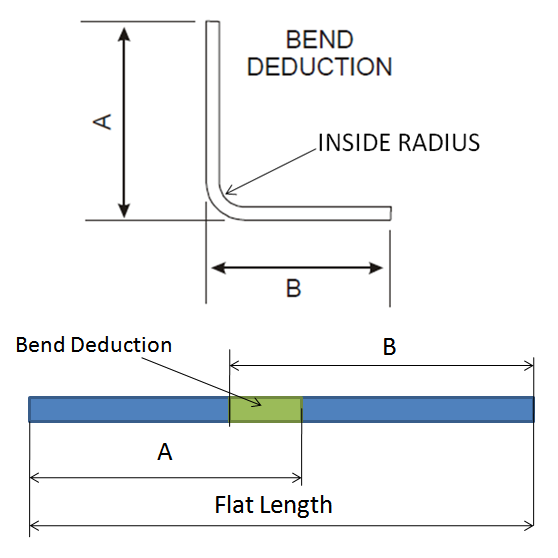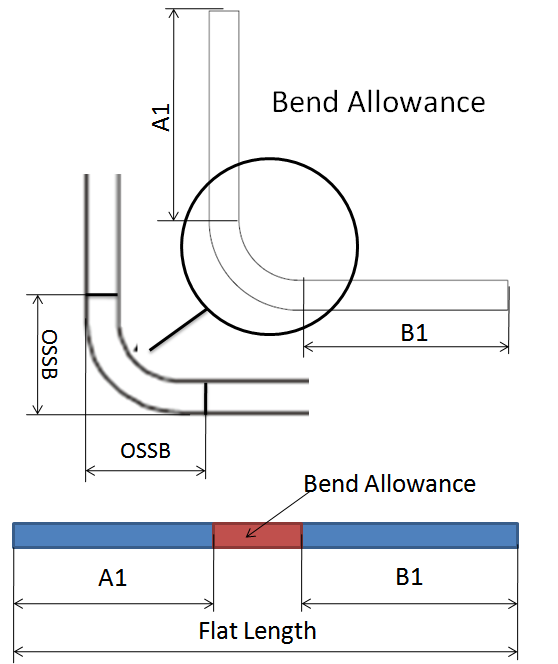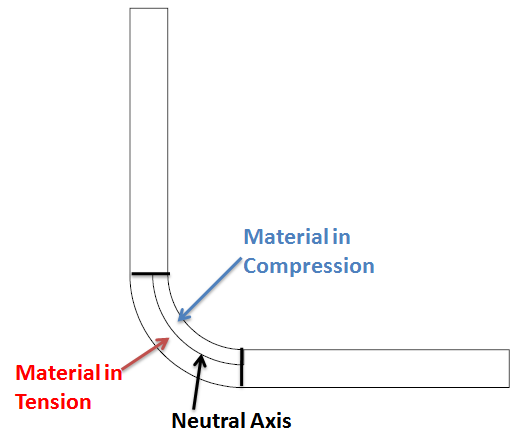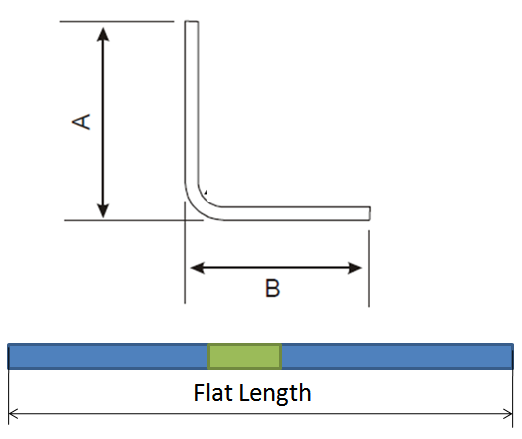K Factor in sheet metal bending is a constant used to calculate sheet metal flat length or Flat-pattern. Mathematically k factor value is equal to the ratio of position of the neutral axis and sheet thickness. In this article, we will discuss sheetmetal bend deduction, bend allowance, K-factor, Y-factor, and sheet metal flat pattern calculations.
To understand what is K Factor? firstly we need to understand why we need K-Factor? what are bend allowance and bend deduction in sheet metal parts?
Why do we need K Factor during Sheet Metal Bending

Sheet metal bending is a forming operation where sheets are deformed plastically to change their shape. During sheetmetal bending, the material is stressed beyond its yield strength but below the ultimate tensile strength.
After bending a sheet metal part, the total length of sheet metal is more than the flat length. This change in length can be represented as bend deduction or bend allowance. This bend allowance and bend deduction are calculated using a constant known as the K factor or Y factor.
What is Bend Deduction in Sheet Metal?
During sheet metal bending, the inside surface of the bend is compressed and the outer surface is stretched. Which increases total outer surface area. In other words, after bending, the total sheet-metal part length (A + B) will be greater than the sheet metal Flat Length.
Mathematically Bend Deduction is equal to the difference between the total sheet metal length after bending and flat length.
Bend Deduction = Total Sheet Metal Bend Length (A+B) – Bend Length

In the above image, this increase in total sheet metal length is represented by bend deduction that needs to be compensated during sheet metal blank size calculations.
Bend Deduction Calculations in Sheet Metal Parts
Total bend deduction in sheet metal parts can be calculated by using the following formula:
Sheet Metal Flat Length = Length A + Length B – Bend Deduction
Bend Deduction = Length A + Length B – Sheet Metal Flat Length
What is Sheet Metal Bend Allowance ?
Bend allowance serves the same purpose as the bend deduction. But compared to bend deduction, sheet metal bend allowance calculates the material that needs to be added to the flange length (A1 and B1) to calculate sheet metal flat length.

Sheet Metal Bend Allowance Calculation Formula
As shown in the above image:
Sheet Metal Flat Length = Length A1 + Length B1 + Bend Allowance
Bend Allowance = Sheet Metal Flat Length – (Length A1 + Length B1 )
Relationship between Sheet Metal Bend Allowance and Bend Deduction
Sheet Metal Bend allowance and bend deduction are directly related to each other. Mathematically the sum of bend allowance and bend deduction is equal to two times of outside setback.
Bend Allowance + Bend Deduction = 2 × OSSB
From the above equation, if the value of outside setback is known, bend allowance can be calculated from bend deduction and vice-versa.
Mathematically outside setback is equal to the product of the sum of sheet thickness & inside bend radius and tangent of the half of bending angle.
Outside Setback ( OSSB ) = Tan (A / 2) × (T + R)
Where :
A = Bending Angle; T = Sheet Thickness, R = Inside Bend Radius
What is K Factor in Sheet Metal?
K Factor in sheet metal bending is a constant that is used to calculate sheet metal flat length. Its value is a constant for a given material, thickness, and machine. The value of K-Factor may vary from machine to machine as well.
If the value of k factor for given material thickness and bending machine is known. Sheet metal flat length can be calculated from a part 3D CAD model using cad software. Therefore k-factor eliminates the need of calculating sheet metal flat length manually. But good practice is to always verify sheet metal flat patterns calculated by CAD software manually as well.
K factor Calculation
K-Factor for sheet metal bending can be calculated either by calculating the position of the neutral axis or by calculating bend allowance or bend deduction. Here are more details on how to calculate the value of K-Factor for sheet metal bending?
Option-1 : Neutral Axis and K factor Calculation
To understand the relationship between the K factor and neutral axis, firstly we need to understand what is a neutral axis in sheet metal bending?
During sheet metal bending, the inside bend surface is compressed whereas the outer bend surface is stretched. Somewhere in between the thickness of material lies a neutral axis where the material is neither compressed or stretched.

The position of the neutral axis depends on the material, grain direction, tooling, and environmental conditions. Mathematically K factor is the ratio of the position of the neutral axis and sheet thickness.
K-Factor = Position of neutral axis / Material thickness
Option-2: Bend allowance and K factor Calculations
There is a direct relationship between sheet metal bend allowance and the K-factor. Mathematically bend allowance during Sheet metal bending can be calculated as per the following formula.
Bend Allowance (BA) = (Π/180) × ( R + K×T) × A
Where
R = Inside Bend Radius; A = Bending Angle; T = Sheet Thickness; K = Value of K-Factor

In the above bend allowance formula, except for sheet metal k-factor and bend allowance values, all other values are known. Therefore to calculate the value of the k-factor firstly we need to calculate the value of bend allowance.
The value of a bend allowance for a material can be calculated using an experiment in the following steps.
Step-1: Take the sample
Cut a sample sheet and measure its total flat length and sheet thickness in mm. Strip width is not very critical.
Step-2: Bend the metal part
Bend the sheet to 90 degrees and measure lengths A and B.
(Please note the bending of the sample part is done in the same manner as we are planning for production. Because different machines and bending tools give different k factor values.)
Step-3
The value of the inside bend radius depends on the bending tool and die. Generally, it is considered equal to sheet thickness.
Facts about K-Factor
- K-Factor is a dimensionless quantity.
- Inside compression in sheet metal cannot exceed the outside tension. Therefore the value of k-factor can not exceed “0.5”.
- The neutral axis cannot go beyond the middle of the sheet thickness.
- K factor Value is inversely proportional to sheet thickness. An increase in thickness decreases the k-factor value.
- K factor value is inversely proportional to material hardness. Therefore with an Increase in hardness, the K factor value decreases.
Relationship between K-Factor and Y-Factor
Similar to the K factor, the Y factor is also a constant used to calculate sheet metal part developed length. Y-factor and k-factor are directly related to each other using the following formula.

Sheet Metal Flat Length Calculation

If the value of sheet metal K factor and bending flange length is known. Sheet Metal flat length can be calculated in the following three steps.
Step-1: Calculate the value bend allowance for the required sheet metal bend by using the below formula.
Bend Allowance (BA) = (Π/180) × ( R + K×T) × A
Step-2: Calculate the value of bend deduction from the values of bend allowance and outside setback.
Bend Allowance + Bend Deduction = 2 × OSSB
Outside Setback = Tan (A / 2) × (T + R)
Step-3: Calculate sheet metal flat length
Flat Length = Length A + Length B – Bend Deduction
To sum up, Sheet metal flat pattern can be calculated using the k factor. And k factor value can be determined by calculating the position of the neutral axis or bend allowance. Calculation of the neutral axis position is a tough task. Whereas bend allowance can be calculated by using reverse engineering method.
We will keep adding more updates on sheet metal K-factor and flat pattern calculations. Please add your suggestions, comments, or questions on sheet metal K factor, bend allowance, and flat length calculations in the comment box.

Hi smlease.com owner, You always provide clear explanations and step-by-step instructions.